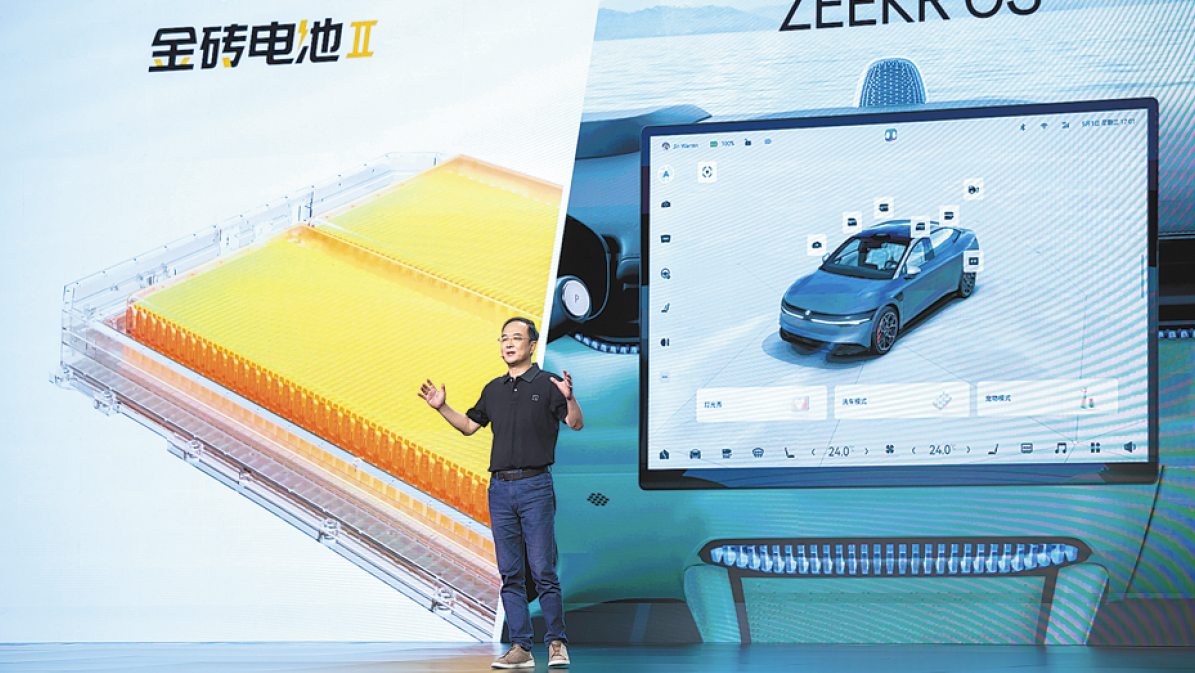
Zeekr CEO Andy An explains some of the company’s latest technologies at a vehicle launch event on Aug 13. [Photo provided to China Daily]
New energy vehicle models are hitting the market in China at a faster speed than their gasoline-powered siblings, as carmakers are constantly pushing the frontiers of technology amid fierce competition in the fast-evolving sector.
Technological breakthroughs, coupled with the sector’s dynamics, are making frequent NEV product launches a “new normal” for the foreseeable future, to the benefit of both car buyers and the overall sector.
In the first half of the year, at least 66 electric vehicles, plug-in hybrids and range-extended models were launched in China, offering customers an abundant choice.
In contrast, only 11 gasoline vehicles hit the Chinese market in the same period, according to the China Passenger Car Association.
Also, NEV updates are more frequent than in the age of gasoline vehicles, when facelifts would take three years and new models need six or seven years.
That time frame would be unimaginable for NEV makers. Aito, a brand codeveloped by Huawei and Seres, launched five variants of its M5 SUV over 26 months. Also, four variants of the Aito M7 became available over 22 months.
It is all because of the nature of technology. Moore’s Law, which originally applied to consumer electronics, has found itself working equally well in the NEV sector, which is becoming a major chip user.
Moore’s Law is named after Intel co-founder Gordon Moore, who predicted that the number of transistors on an integrated circuit will double every two years with a minimal rise in cost.
It has taken Huawei just a year to upgrade its driving-assist system from the 2.0 version to the 3.0 version. The 3.0 ADS is now available on the Stelato S9 sedan produced by BAIC’s premium arm, Arcfox.
Zeekr, the premium unit of Geely, launched the 2025 version of the 001 shooting brake and 007 sedan earlier this month.
They feature the marque’s latest technologies in smart driving, smart cabin functions and batteries, but the prices have remained basically unchanged compared with the previous version.
Among other things, the second-generation Golden Battery can be charged from 10 percent to 80 percent in 10-and-a-half minutes using its ultrafast charging stations.
“Thanks to the optimized materials and upgraded technology, the speed is higher than what is achieved by existing nickel-cobalt-manganese batteries,” Zeekr said.
Zeekr said it had opened more than 500 ultrafast charging stations across the country by June, offering more than 2,700 charging piles in total.
Its facilities support 800-volt charging, while most batteries and domestic charging infrastructure support 400-V charging.
The company has also introduced its own smart driving solutions to 2025 vehicles, offering a new alternative to the Mobileye driving assistance in response to user demand.
Mark Rainford, a China-based car industry commentator, said the competition in China is incredibly fierce. He added that while brands like BYD prioritize scale and sales, brands like Zeekr and Nio are focused on maximizing the user experience.
Zeekr spent $361 million in research and development for the second quarter of 2024, representing an increase of 89.6 percent year-on-year and an increase of 36.3 percent from the first quarter, according to its financial statements.
In May, Zeekr went public on the New York Stock Exchange, the first major US market debut by a Chinese company since 2021.
“As we progress through the second half of 2024, our core objectives remain unchanged: to continuously invest in research and development, ensuring we stay at the forefront of technological innovation to drive our business forward and deliver long-term value for our shareholders,” said Zeekr CEO Andy An.
Shi Jianhua, deputy secretary-general of the China EV 100 think tank, said carmakers have to rely on sustainable technological innovation and progress if they want to gain a firm footing and consolidate their position in the highly competitive market.
Retail sales of NEVs accounted for 51.1 percent of total passenger vehicle deliveries in China in July, outnumbering conventional internal combustion engine vehicles for the first time, according to the China Passenger Car Association.
The figure marked a hike of 15 percentage points compared with the same month of 2023, said the CPCA. In the first seven months, retail sales of NEVs totaled 4.99 million units, up 33.7 percent from the same period of 2023.
The “higher penetration rate of EVs has encouraged more producers to upgrade their technologies,” said Chen Jinzhu, CEO of consultancy Shanghai Mingliang Auto Service.
lifusheng@chinadaily.com.cn
